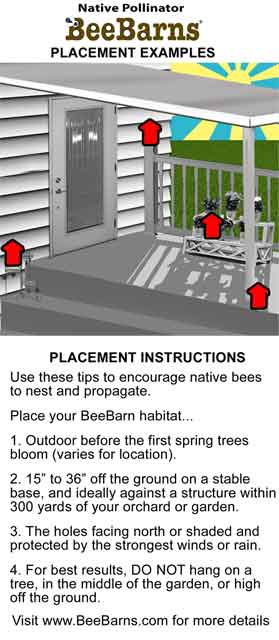About tunnel nesting native bee habitat use
|
|
 |
Your native bee house is made to be an ideal habitat for native tunnel nesting pollinators, but it should be placed in a dry shady location for best results. While they may forage in the middle of your garden, native bees seek out nesting sites away from other insects and birds, protected from direct rain and sun. Ideal nesting areas are typically on or near existing structures such as sheds, arbors or under decks. Keep in mind these are NOT Carpenter bees and the bees that will nest in your bee house cannot make holes of their own.
Placing your native bee house in your garden
Min. 18" off the ground.
Ideally, you want to place your native bee house no less than 18" inches off the ground to prevent heavy rain from splashing back up from the ground and saturating the bee hive, and to prevent snow from covering the house.
Max. 7' off the ground.
There is no particular reason to place your native bee house higher than 7'. The primary reason for choosing a high location is to create some distance between you and the bees as they establish a flight path to and from the nesting site.
Front (holes) facing North/East
Generally you want place your native bee house facing north to northeast to recieve morning sun, if any, while avoiding the hot late day sun.
|
|
My Personal experience regarding placement
While I have a 1/4 acre garden behing my home, the Blue Orchard bees prefer to nest in the nesting houses I have placed on my front porch, slightly away from the garden flowers. The bees seem to understand that my covered porch, slightly off the ground is good shelter. We enjoy watching them and because they are solitary and not defensive like colony bees, we cohabitate well.
|
|
|
|
|
|
|
|
|
|
|
© 2010 Intrinsic Spin Media llc. ALL RIGHT RESERVED
|
|

